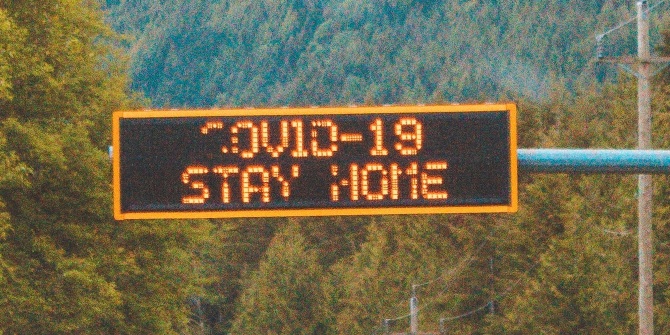 Given the country’s condition today, the 2011 military intervention by NATO in Libya is now seen as having largely been a failure. Gustav Meibauer argues that NATO’s failure in that country has also now tainted the utility of no-fly zones as an intervention in such conflicts. While previously regarded as a relatively low-cost intervention that goes beyond sanctions, the relatively forceful imposition of the Libyan no-fly zone means that the policy tool is now viewed with suspicion.
Given the country’s condition today, the 2011 military intervention by NATO in Libya is now seen as having largely been a failure. Gustav Meibauer argues that NATO’s failure in that country has also now tainted the utility of no-fly zones as an intervention in such conflicts. While previously regarded as a relatively low-cost intervention that goes beyond sanctions, the relatively forceful imposition of the Libyan no-fly zone means that the policy tool is now viewed with suspicion.
There is now relatively wide agreement that the 2011 Libyan intervention was flawed in many ways. After all, it led to a completely dysfunctional entity in a state of de-facto civil war. But it was also disastrous from another perspective; the way in which a no-fly zone was used in the Libyan intervention may have made its future use as a tool of US foreign policy impossible. Why does that matter?

When policy-makers are faced with the decision over what to do vis-à-vis a specific conflict, they may encounter what’s called a sanctions-force gap. Theoretically, different alternative courses of action that decision-makers have when it comes to international crisis management can be depicted in a “ladder of escalation”, ascending in terms of seriousness, impact and risk.
On the one side (towards the top of the ladder), we would find tools of military force: strategic air campaigns, ground intervention and the like. Describing the no-fly zone as one such tool makes intuitive sense – because jets do lift off and things will explode. Because of the levels of commitment and risk of such tools, it is often assumed that decision-makers ponder these forceful alternatives very carefully and rationally. Together with their military experts and advisers, they assess whether a specific situation merits the use of military force, considering the national interest, but also international law, the position of international allies and adversaries, domestic public opinion and elites, and so forth. Decision-makers might well find that the climb to using full-on military force to intervene in intra-state conflict is very difficult to make indeed.
On the other side of the ladder, towards the bottom, we find sanctions tools (e.g. re-calling ambassadors, freezing financial assets, economic boycotts). These tools do not directly apply military force, and hence are assumed to be less risky and less costly (to the sender). Correspondingly, regulations of national and international law, the intra-administrative decision path and often the seniority of people involved differ between crisis-related sanctions and full-blown military intervention. Hence, the difference in seriousness is directly reflected in how complicated the decision-making process has become. When it comes to sanctions, decision-makers are assumed to be less strictly rational, less strictly focused on the primary objective. Instead, in addition to what they might actually be useful for, sanctions might also help decision-makers deal with political dilemmas (e.g. the necessity to demonstrate resolve but also conciliate domestic audiences); so far so that it might not even matter what their intended or actual primary effect is.
The problem arises when decision-makers are pressed to consider the transition from sanctions to military force. Consider the example of an intra-state conflict somewhere on the globe in which the US feels it has at least some interest. All sorts of sanctions have been applied, but they have not shown the desired effects; or alternatively, decision-makers perceive pressure to do something more either to increase diplomatic pressure on the conflict parties, to appease domestic hardliners, or because their conscience dictates it. It is at that point where decision-makers encounter the sanctions-force gap: the void of grey between white and supposedly “easy” sanctions, and dark and difficult-to-do forceful intervention.

No-fly zones, because of specific inherent characteristics, can be perceived as closing that gap, which made them attractive to policy makers in past cases. A no-fly zone is a distinct space in which a state or alliance patrols by the means of control flights to ensure implementation of whatever rules it set to hold therein, and specifically to deny another state the use of that designated air space. By this definition, the no-fly zone is not necessarily limited to the interdiction of flyovers, which is simply one necessary condition to enforcement and may precede other “rules” that the patrolling state wants to enforce. Clearly, then, no-fly zones are distinct from economic sanctions in that they directly apply military force. Indeed, no-fly zones would effectively capture and occupy a part of the opponent’s territory (air space), most likely preventively destroy equipment and forces that may threaten air superiority both inside and at the borders of its demarcation, and credibly threaten to use the established air superiority to compel the other side.
In other ways, however, no-fly zones are thought to share characteristics with sanctions. Firstly, unless explicitly stated (and then sometimes colloquially labelled a “no-movement zone” or “no-drive zone”), there is an expectation that no-fly zones will single out (at times somewhat arbitrarily) a specific part of adversarial capabilities (namely air-related assets) for suppression. Secondly, rules are enforced only within the distinct territory of the no-fly zone, implying that elsewhere the opponent may still govern its air space as it pleases (although the Libya no-fly zone may have reduced that argument significantly). Thirdly, the no-fly zone in general is rule-bound, which is closely interrelated with the preceding arguments. Included in a no-fly zone declaration is a list of specific violations of its rules which may lead to the use of force. If, however, the opponent complies, the no-fly zone seems, as long as air superiority is not threatened, to be a rather passive-defensive tool of air power. In its narrower interpretation, a no-fly zone freezes a status quo on the ground. Also, as air strikes are dependent on escalating moves of the adversarial conflict party, the no-fly zone might not present an ongoing international debate with quick faits accomplis: once transgressions are effectively discouraged, air strikes should stop.
Credit: Defence Images (Flickr, CC-BY-NC-2.0)
Fourthly, a no-fly zone at least in theory is relatively easily retractable if the adversary assures compliance (albeit with the danger of “perpetual patrol”), yet also flexible enough to enable further coercive measures (albeit with the danger of “mission creep”). Fifthly, no-fly zones are relatively cheap, given the infrastructure to enforce them (air bases or carriers). They can also be implemented quickly, as little materiel and personnel have to be moved and air components can cover additional distance – most assets are essentially removed from the theater of conflict for the entire duration of the intervention. Most importantly, there is a clear expectation that no-fly zones very rarely result in loss of own materiel or life. Lastly, no-fly zones have so far been implemented multilaterally, which, particularly if overseen by international bodies, makes unilateral hawkish decisions more difficult both in theory and practice.
In this way, no-fly zones have some features that make it seem like they bridge the sanctions-force gap to some extent. This is why no-fly zones and other such “hybrid tools” appear attractive to decision-makers looking to turn the screw a bit more and signal commitment to stated primary objectives, but shying away from more high-cost operations. No-fly zones allow decision-makers to seemingly evade a complex dilemma between doing nothing (more) and risking a lot. They also serve to satisfy underlying secondary objectives (such as signaling commitment, playing to public opinion, and accommodating both critics and proponents of intervention domestically and abroad). Decision-makers would rely on the no-fly zone knowing that it is not an optimal tool to intervene into intra-state conflict, but rather because they interpret it as an acceptable solution.
But not anymore. It remains a topic of debate whether the way the Libyan intervention panned out was legal and/or legitimate, and the assessment of decision-making processes and resolution texts is still some way from establishing a scholarly consensus. Did the US and its NATO allies trick opponents of military intervention into accepting a no-fly zone? Did they truthfully signal that something more forceful was the plan all along, and the opponents simply did not grasp that in the Security Council’s chaotic negotiations? Either way, the Libyan intervention has placed the no-fly zone, in the view of many international actors, firmly in the force side of the escalation ladder. With the (re-)interpretation of Resolution 1973’s mandate having set precedent, international opposition to future interventions will not only be more watchful of the exact terms, conditions, and rules of engagement of a potential no-fly zone, but might in fact veto it altogether, either for fear that it would be used in contempt of their intentions again, or because another imposition could be understood as after-the-fact acceptance of the Libyan intervention.
This could be seen in Syria, where early calls for a no-fly zone similar to Libya were met not with scepticism, but instead with outrage: Russia explicitly quoted its strong irritation over the Libyan no-fly zone as a reason for not accepting a similar operation in Syria. As an unfortunate side product of the Libyan intervention, then, US policy makers may have “burned” a very useful foreign policy tool forever. For the US, the way in which the no-fly zone over Libya was interpreted has made processes of international bargaining, coalition-building, opposition management and domestic politics more difficult in a comparable case.
Please read our comments policy before commenting.
Note: This article gives the views of the author, and not the position of USApp– American Politics and Policy, nor of the London School of Economics.
Shortened URL for this post: http://bit.ly/29qh8Nv
______________________
 Gustav Meibauer – LSE International Relations
Gustav Meibauer – LSE International Relations
Gustav Meibauer is a PhD Candidate in International Relations at the LSE. His research focuses on coercive diplomacy, foreign intervention, and foreign policy decision-making.








1 Comments